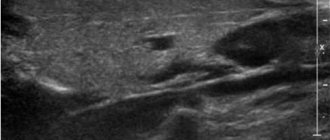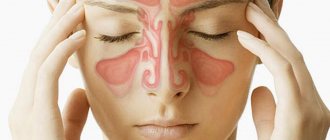Chronic sialadenitis is an inflammation of the salivary glands, in which periods of exacerbation alternate with periods of remission. This type of disease manifests itself differently in men, women and children. During reduced activity of the pathological process, symptoms of the inflammatory process are practically absent. During an exacerbation, there is a painful swelling in the cervical spine, an unpleasant taste in the mouth, and difficult salivation. Treatment is aimed at containing changes in the structure of the salivary gland tissue and eliminating painful symptoms.
Classification of forms of chronic sialadenitis
Depending on the area of localization and similarity of symptoms, three main forms of sialadenitis are distinguished:
- Parenchymal sialadenitis . Parenchyma is the collection of functional cells that make up the salivary gland. The inflammatory process is based on changes in cells of this type. Women are more often susceptible to this form of the disease. Parenchymal sialadenitis affects the parotid salivary glands.
- Interstitial sialadenitis. This type of inflammation occurs in the interlobular space of the gland. Most often it affects men. Interstitial sialadenitis affects the submandibular salivary glands.
- Ductal sialadenitis Occurs due to congenital pathology of the salivary ducts or as a result of their injury. Most often it occurs in older people.
Types of inflammation
Depending on the infectious agency, two types of sialadenitis are distinguished. This:
- viral;
- bacterial.
Viral sialadenitis
The disease is formed as a result of the penetration of the mumps virus into the human body. The disease is known as "mumps". Transmission is carried out by airborne droplets. After entering the body, the virus penetrates the tissue of the parotid salivary gland, causing inflammation. In the generalized form of mumps in men, the testicles are affected, which can subsequently cause infertility.
Important! In some cases, viral sialadenitis develops against the background of cytomegalovirus infection.
Bacterial (nonspecific) sialadenitis
Formed as a result of infection through the oral cavity. Provoking factors may be:
- Poor oral hygiene.
- Reactive obturation. The resulting narrowing of the duct causes a reduced volume of saliva secreted. The accumulated secretion becomes a convenient environment for the proliferation of pathogenic microflora, which is constantly present in the oral cavity.
- Mechanical obturation. Develops as a result of blocking the lumen of the duct. Pathogens actively multiply in the collected saliva, causing inflammation.
The bacterial form of sialadenitis develops as a result of infection of the ducts of the oral cavity
The second option for infection is transmission through the blood. The cause may be severe infectious pathologies, in particular scarlet fever. The third way of infection of the salivary gland is through the lymph. The cause is inflammatory pathologies of the face, oral mucosa and pharynx. To be honest, periodontitis, furunculosis or tonsillitis.
The chronic form of sialadenitis develops as an independent disease. The reasons may lie at the genetic level. Sometimes inflammation is a response to an autoimmune pathology or some general disease. Quite often, a chronic form of inflammation is recorded in the category of elderly patients, which is due to a deterioration in the blood supply to the organ.
2. Reasons
The etiopathogenesis of calculous sialadenitis is currently being actively studied and clarified. Apparently, the disease should be considered polyetiological and multifactorial, i.e. One or more of many possible causes may lead to its development, making prediction and prevention extremely difficult.
The most significant is considered to be the role of congenital anomalies in the structure of the salivary gland, in which the outflow of saliva and the leaching of solid organic and mineral microparticles are hampered. Amino acids predominate in the composition of stones.
The forming sialolith (sizes in different cases vary from fractions of a millimeter to several centimeters), in turn, expands the duct, creating abnormal mechanical pressure. Stagnation in the salivary gland, as in any other organ, creates direct preconditions for infection and inflammation; sooner or later an infection occurs, which forms a characteristic clinical picture.
Risk factors include an imbalance in the circulation of calcium and phosphorus compounds in the body, vitamin A deficiency, etc.
Visit our General Surgery page
Symptoms of inflammation of the salivary glands
The general symptoms of the disease are as follows:
- dryness of the oral mucosa due to lack of salivary fluid;
- shooting pains;
- pain accompanying chewing, swallowing food and opening the mouth;
- swelling and hyperemia of the skin in the projection of the salivary gland;
- unpleasant taste of saliva;
- possible appearance of purulent contents;
- painful formation in the area of inflammation;
- a feeling of fullness, which indicates the accumulation of pus;
- increased general body temperature and weakness.
The most severe inflammation of the parotid salivary gland is caused by the mumps virus entering the body.
Mumps - mumps - is especially dangerous, since other glands of the body, for example, the pancreas, can be involved in the pathological process. Symptoms of inflammation include: acute onset with an increase in body temperature to 39–40 degrees, swelling in the area of the parotid salivary gland, pain that intensifies during chewing.
Acute sialadenitis of the parotid salivary gland occurs in several stages, each of which is accompanied by certain symptoms.
- Serous sialadenitis. It is typically characterized by dryness of the oral mucosa, soreness in the ear area, and the development of slight swelling. The lobe is slightly raised upward. Increased pain is recorded during eating. The increase in body temperature is slight.
- Purulent stage. Characterized by increased pain. There is an increase in body temperature above 38 degrees, increased swelling, and restriction when opening the mouth. When pressing on the area of inflammation, purulent masses flow. The gland is dense and painful.
- Gangrenous inflammation. An abscess forms over the inflamed gland, serving as an outlet for dead tissue.
In the absence of adequate drug therapy, death due to the development of sepsis cannot be ruled out. The cause may be internal bleeding caused by the melting of the walls of large blood vessels in the neck.
Symptoms of chronic inflammation depend on the current form of the disease:
Damage to the salivary glands
- Chronic interstitial sialadenitis. Most often it develops in the parotid glands (about 85%). It is diagnosed in most cases in elderly patients. It remains asymptomatic for a long time. The development of the clinical picture is due to a deterioration in the condition caused by a narrowing of the ductal lumen. A sign of exacerbation is the appearance of a feeling of dry mouth and an increase in the size of the gland. It becomes painful when touched.
- Chronic parenchymal sialadenitis. Mostly women suffer from it. In the initial stage of development, when pressure is applied to the gland, a significant volume of salty-tasting liquid is released. Later, a feeling of heaviness and compaction develops. It is possible that saliva may be released with admixtures of pus and mucous lumps. In the later stages, the gland is painless, lumpy, and discharge of pus is observed.
- Sialodochitis is inflammation of the ducts. A typical symptom is increased production of salivary fluid during eating and talking, as well as the formation of congestion in the corners of the mouth. During the period of exacerbation of the pathology, impurities of pus are present in the saliva, the gland becomes swollen and dense.
Diagnostics
Acute sialadenitis is diagnosed by examining the patient and collecting existing complaints. The sialography procedure is used in rare cases, since the introduction of a contrast agent causes increased pain.
Differential diagnosis is necessary for the correct choice of treatment method
To confirm chronic sialoadenitis of the parotid salivary gland, contrast sialography is used. It allows you to determine the current form of the pathology. Narrowing of the lumen of the duct is typical for the interstitial form of inflammation. In this case, the volume of contrast agent penetrated into the gland tissue does not exceed 0.8 ml.
A healthy organ holds approximately 2–3 ml. In the parenchymal format of sialadenitis, numerous cavities with a diameter of up to 10 mm are recorded. The tissues of the gland and the ducts themselves are not determined. The capacity of the cavities is 6...8 ml of contrast.
Treatment of the disease
Treatment of sialadenitis should be carried out by a specialized specialist. Incorrectly selected therapy can cause complications. Uncomplicated forms of inflammation are treated on an outpatient basis (at home). The patient will be advised to:
- compliance with bed rest;
- gentle diet - food should be crushed, which reduces pain when swallowing and chewing;
- Drinking plenty of fluids helps reduce the symptoms of intoxication.
Local treatment gives excellent results. Any dry bandages with a warming effect can be applied to the area of the inflamed parotid salivary gland. Compresses based on alcohol and camphor oil help well. In addition, the patient will be recommended to visit a physiotherapy office. The most commonly prescribed procedures are UHF and Sollux.
To ensure the outflow of saliva from the inflamed gland, artificial stimulation is necessary. Any foods with a sour taste, for example, lemon slices, cranberries, sauerkraut, help with this. The body, in response to irritation of taste buds, automatically increases the production of saliva.
In order to activate the process of salivation, you can use medications, in particular, a solution of pilocarpine hydrochloride. At what point the patient should stimulate the secretion of saliva will be decided by the attending physician, based on the current symptoms.
Important! Stimulating the secretion of saliva helps to avoid stagnation and promotes the removal of dead tissue cells from the inflamed gland.
When the body temperature rises and the pain accompanying sialadenitis is relieved, the patient is allowed to take drugs from the NSAID group - Analgin, Pentalgin, Baralgin, Ibuprofen and others. The drugs have analgesic, anti-inflammatory and antipyretic effects.
In the absence of a therapeutic result and a deterioration in general health - there are no improvements within 3 days - or signs of suppuration of the gland appear, the patient is prescribed antibiotics.
If necessary, surgical therapy is performed: opening and draining the inflamed gland, in the presence of a significant volume of purulent masses. Antibacterial drugs are injected directly into the site of inflammation.
If suppuration develops, the patient is recommended to undergo surgical treatment - opening and drainage of the gland
Treatment of inflammation of the parotid salivary gland is a long and complex process. In case of exacerbation, the patient is prescribed drugs from the group of antibiotics and medications that stimulate the production and discharge of saliva.
X-ray therapy shows a good therapeutic result for the chronic form of sialadenitis. When diagnosing stones in the ducts of the gland - the calculous form of sialadenitis - surgical treatment is prescribed.
Traditional medicine in the treatment of sialadenitis
Drugs from this category really help reduce symptoms, but do not stop the progression of the inflammatory process. Therefore, before using decoctions, you should consult a doctor and do not refuse drug treatment. The most effective in the treatment of sialadenitis are decoctions of:
- chamomile flowers and eucalyptus leaves;
- peppermint leaves and elderflower flowers;
- yarrow and viburnum leaves.
In any case, visiting a doctor is inevitable. You can make an appointment with a specialist on our website.
Prevention of the development of sialadenitis
There is no specific prevention - the introduction of a specialized vaccine - for sialadenitis. The exception is mumps. Vaccination is carried out with a three-component drug that is effective against three diseases at once - mumps, measles and rubella. All children aged 1.5 years are vaccinated. Lasting immunity is developed in approximately 96% of vaccinated children.
Nonspecific prevention is as follows:
- regular oral hygiene;
- sanitization of all foci of inflammation in the mouth;
- prevention of saliva stagnation;
- rinsing the mouth during infectious pathologies.
Inflammation of the parotid salivary gland is treated by a dentist. If there are signs of mumps development, the child should be shown to a pediatrician. In this case, adult patients turn to a therapist.
How is sialadenitis treated?
Regardless of the form and type of disease, the patient is given antibacterial therapy. If the course of the disease is mild, then it is enough to undergo a course of physiotherapy and take several injections of antibiotics directly into the inflamed duct of the salivary gland. If acute sialadenitis of the salivary glands is of moderate severity, then painkillers and a course of antibiotics (10-14 days intramuscularly) can be prescribed.
Severe sialadenitis, characterized by the formation of stones in the salivary ducts, requires surgical intervention. For small stones, an ultrasonic crushing procedure is recommended. For larger ones, endoscopic surgery is performed.
Physiotherapy is prescribed:
- therapeutic massage of the salivary gland;
- electrophoresis;
- UHF;
- galvanization.
Most often, the acute form of the disease has a favorable prognosis. With proper treatment, recovery occurs within two weeks. It is important to identify the pathology in time, so the primary diagnosis of sialadenitis in children falls under the responsibility of the parents. If a child begins to complain of pain in the ear, discomfort when swallowing, or an unpleasant taste in the mouth, then you should immediately contact your pediatrician. Even before the appearance of characteristic and pronounced symptoms, swelling of the neck and slight redness of the neck and face are possible - these are also alarming symptoms.








